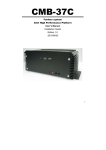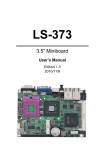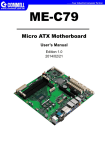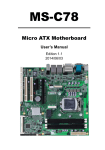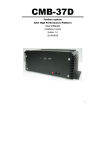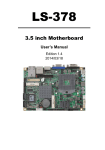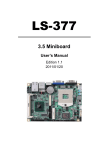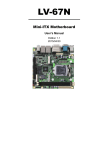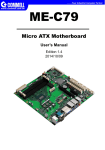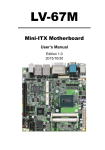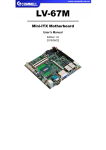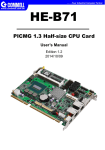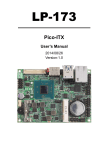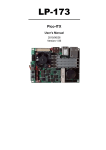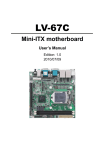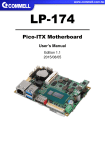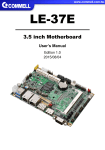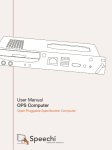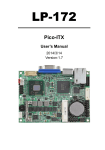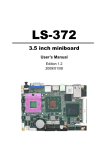Download User`s manual
Transcript
LE-37C 3.5 inch Motherboard User’s Manual Edition 1.8 2015/06/16 LE-37C User’s Manual Copyright Copyright 2014, all rights reserved. This document is copyrighted and all rights are reserved. The information in this document is subject to change without prior notice to make improvements to the products. This document contains proprietary information and protected by copyright. No part of this document may be reproduced, copied, or translated in any form or any means without prior written permission of the manufacturer. All trademarks and/or registered trademarks contains in this document are property of their respective owners. Disclaimer The company shall not be liable for any incidental or consequential damages resulting from the performance or use of this product. The company does not issue a warranty of any kind, express or implied, including without limitation implied warranties of merchantability or fitness for a particular purpose. The company has the right to revise the manual or include changes in the specifications of the product described within it at any time without notice and without obligation to notify any person of such revision or changes. Trademark All trademarks are the property of their respective holders. Any questions please visit our website at http://www.commell.com.tw TU UT LE-37C User’s Manual Packing List: Please check the package content before you starting using the board. Hardware: LE-37C 3.5 inch Miniboard x 1 (include Cooler Fan) Cable Kit: SATA Cable x 1 (OALSATA3-L)/ (1040529) DC Power Cable x 1 (OALDC-A)/ (1040433) CRT cable without bracket x 1 (OALVGA-SNB-7)/ (1040557) USB2.0 Cable x 1 (OALUSBA-3)/ (1040173) PS/2 Keyboard & Mouse Cable x 1 (OALPS2/KM)/ (1040131) COM Port Cable x 1 (OALES-BKU1NB)/ (1040086) Audio Cable x 1 (OALPJ-HDUNB)/ (1040123) Printed Matters: Driver CD (Including User’s Manual) x 1 Optional : USB3.0 Cable (OALISB3NB)/ (1040532) SATA Power Cable x 1 (OAL4P-S2)/ (1040054) 1 to 3 power output cable x 1 (OAL4P-2)/ (1040051) LE-37C User’s Manual Index Chapter 1 <Introduction> ..............................................................................1 1.1 <Product Overview> ..................................................................................... 1 1.2 <Product Specification>................................................................................ 2 1.3 <Mechanical Drawing> ................................................................................. 3 1.4 <Block Diagram>.......................................................................................... 4 Chapter 2 <Hardware Setup>........................................................................5 2.1 <Connector Location> .................................................................................. 5 2.2 <Jumper Location & Reference>.................................................................. 6 2.3 <Connector Reference> ............................................................................... 7 2.3.1 <Internal Connectors> ..................................................................... 7 2.3.2 <External Connectors> .................................................................... 7 2.4 <Memory and CFAST Setup> ...................................................................... 8 2.4.1 < Memory Setup > ........................................................................... 8 2.4.2 < CFAST Setup >............................................................................. 9 2.5 <CMOS & ATX Setup> ............................................................................... 10 2.6 <Serial ATA Interface> ................................................................................ 11 2.7 <Ethernet Interface>................................................................................... 12 2.8 <Onboard Display Interface>...................................................................... 13 2.8.1 <External Display>......................................................................... 13 2.8.2 <Internal Display> .......................................................................... 14 2.9 <Integrated Audio Interface> ...................................................................... 19 2.10 <USB Interface>....................................................................................... 20 2.11 <Serial Port>............................................................................................. 22 2.12 <PCIe Mini Card and SIM Interface>........................................................ 24 2.12.1 <SIM Setup> ................................................................................ 26 2.13 <GPIO and SMBUS Interface>................................................................. 28 2.14 <Power Supply and Fan Interface > ......................................................... 29 2.14.1 <Power Input>.............................................................................. 29 2.14.2 <Power Output>........................................................................... 29 LE-37C User’s Manual 2.14.3 <Fan connector>.......................................................................... 30 2.15 <Switch and Indicator> ............................................................................. 31 Chapter 3 <System Setup> .........................................................................32 3.1 <Audio Configuration>................................................................................ 32 3.2 <Display Properties Setting> ...................................................................... 33 3.3 <SATA configuration> ................................................................................. 35 3.4 <SATA RAID Configuration>....................................................................... 36 Chapter 4 <BIOS Setup> .............................................................................37 Appendix A <I/O Port Pin Assignment>.....................................................38 A.1 <Serial ATA Port> ....................................................................................... 38 A.2 <IrDA Port> ................................................................................................ 38 A.3 <LAN Port> ................................................................................................ 38 A.4 <LPC Port> ................................................................................................ 38 Appendix B <Flash BIOS> ..........................................................................39 B.1 <Flash Tool> .............................................................................................. 39 B.2 <Flash BIOS Procedure> ........................................................................... 39 Appendix C <Programming GPIO’s> .........................................................40 Appendix D <Programming Watchdog Timer > ........................................41 Contact Information.....................................................................................42 LE-37C User’s Manual Chapter 1 <Introduction> 1.1 <Product Overview> LE-37C the 4th Generation Intel of the 3.5 inch miniboard, supports 4th Generation Intel® Core™ i7, Core™ i5, Core™ i3, Celeron Mobile Processor and features Intel DH82QM87 chipset, integrated HD Graphics, DDR3L memory, REALTEK High Definition Audio, Serial ATA with AHCI and RAID function for a system and Intel Gigabit LAN. Intel Haswell Bridge Processor The 4th Generation Intel® Core™ processor family mobile is the next generation of 64-bit, multi-core mobile processor built on 22- nanometer process technology. Based on a new micro-architecture. New features for Intel DH82QM87 chipset The DH82QM87 chipset provides better CPU, graphics, media performance, flexibility and more enhanced security that is suitable for a variety of intelligent systems the ideal choice. All in One multimedia solution Based on Intel DH82QM87 chipset, the board provides high performance onboard graphics, CRT, 24-bit dual channel LVDS interface, DisplayPort, DVI and 2 channels High Definition Audio, to meet the very requirement of the multimedia application. Flexible Extension Interface The board provides two PCIe mini slot and one SIM slot. -1- LE-37C User’s Manual 1.2 <Product Specification> General Specification Form Factor 3.5 inch Miniboard CPU 4th Generation Intel® Core™ i7, Core™ i5, Core™ i3, Celeron Mobile Processor. Package type: FCBGA1364 Memory 1 x DDR3L SO-DIMM 1333/1600 MHz up to 8GB Support Non-ECC, unbuffered memory only Chipset Intel® DH82QM87 PCH Real Time Clock Chipset integrated RTC with onboard lithium battery Watchdog Timer Generates a system reset with internal timer for 1min/s ~ 255min/s Power Management Support ACPI 4.0 compliant Serial ATA Interface 2 x serial ATA3 interface with 600MB/s transfer rate (Only for SATA3) Display Interface Intel® 4th Generation Core mobile processor integrated HD Graphics 4600 1 x CRT (Onboard 2x8 pin-header) 1 x DVI (Rear I/O connector) 1 x DisplayPort (Rear I/O Port) 1 x LVDS (Onboard 24-bit dual channel connector with +3.3/+5/+12V supply) Audio Interface Realtek ALC888 HD Audio LAN Interface 1 x Intel® I217-LM Gigabit LAN (Support iAMT9.0) GPIO Interface Onboard programmable 12 pin-header, 8-bit Digital I/O interface Extended Interface 2 x Mini PCIe slot, 1 x SIM slot, 1 x CFAST (Optional support mSATA (Only for SATA3) for Mini_Card1) Internal I/O Port 1 x RS232/422/485, 1 x SMBUS, 1 x GPIO, 2 x USB3.0, 2 x USB2.0, 1 x IrDA, 1 x CRT, 1 x LPC, 1 x LVDS, 1 x LCD inverter, 2 x Serial ATA3 , 1 x DC-Out, 1 x PS/2 and 1 x Front panel Audio External I/O Port 1 x LAN, 1 x DVI, 1x DisplayPort, 2 x USB3.0 and 1 x RS232 Power Requirement 9~24V 4-pin full range DC Input Dimension 146mm x 101mm Temperature Operating within 0~60 centigrade Storage within -20~85 centigrade Ordering Code LE-37C17L i7-4700EQ Mobile Processor, CRT, LVDS, DVI, DisplayPort, LAN, LPC, SATA3, USB2.0, USB3.0, HD Audio , SMBUS, SIM, GPIO, IrDA, DC-Out, PS/2, PCIe mini card, mSATA, CFAST. LE-37C17P Celeron 2002E Mobile Processor, CRT, LVDS, DVI, DisplayPort, LAN, LPC, SATA3, USB2.0, USB3.0, HD Audio, SMBUS, SIM, GPIO, IrDA, DC-Out, PS/2, PCIe mini card, mSATA, CFAST. The specifications may be different as the actual production. For further product information please visit the website at http://www.commell.com.tw TU -2- UT LE-37C User’s Manual 1.3 <Mechanical Drawing> -3- LE-37C User’s Manual 1.4 <Block Diagram> 4th Generation Intel® Core™ i7, Core™ i5, Core™ i3, Celeron Mobile Processor eDP Channel A 1 x LVDS DDI 1 x DisplayPort 1 x DVI 1 x 204-pin DDR3L SO-DIMM 1333/1600 MHz up to 8GB FDI DMI DH82QM87 CRT PCI-E x1 1 x CRT 2 x PCI-E mini card SATA3 USB3.0 2 x SATA 2 x External USB 2 x Internal USB SATA3 1 x CFAST USB2.0 2 x Internal USB ALC888 HD Audio PCI-E x1 SPI 1 x Intel® I217-LM SPI Flash 1 x SMBUS LPC 1 x LPC(TPM) 1 x RS232/422/485 1 x RS232 1 x GPIO W83627DHG-P 1 x PS/2 -4- 1 x IrDA LE-37C User’s Manual Chapter 2 <Hardware Setup> 2.1 <Connector Location> CN_LVDS JVLCD CN_CRT JP1 CN_DIO JMSATA DC_IN CN_USB3 JVUSB CN_USB2 CN_INV SIMM MINI_CARD1 DC_OUT CN_LPC CPUFAN CN_PS/2 SYSFAN CN_AUDIO SATA3-1 CN_COM2 SATA3-2 JP2 JCSEL2 DisplayPort -5- JFRNT CN_IR DVI MINI_CARD2 CN_SMBUS JAT JCSEL1 COM1 JRTC USB RJ45 LE-37C User’s Manual 2.2 <Jumper Location & Reference> Jumper JRTC JVLCD JAT JP1 JP2 JCSEL1 JCSEL2 JVUSB JMSATA Function CMOS Operating/Clear Setting Panel Voltage Setting Power mode select Com1 Voltage Setting (For Pin 9) Com2 Voltage Setting (For Pin 9) CN_COM2 RS-232 RS422 RS485 Setting CN_IR IrDA Setting USB Voltage Setting Mini Card1 mSATA Setting JVLCD JP1 JMSATA JVUSB JCSEL1 JP2 JCSEL2 -6- JRTC JAT LE-37C User’s Manual 2.3 <Connector Reference> 2.3.1 <Internal Connectors> Connector CPU SO-DIMM SATA 1/2 DC_IN DC_OUT CN_AUDIO CN_DIO CN_USB2 CN_USB3 CPUFAN SYSFAN CN_CRT CN_LVDS CN_INV CN_IR CN_COM2 CN_LPC CN_SMBUS JFRNT Mini-PCIe1/2 SIMM CFAST Function FCBGA 1364 CPU 204 -pin DDR3L SO-DIMM slot 7-pin Serial ATA3 connector DC 9~24V input connector 4-pin DC output connector 5 x 2-pin audio connector 6 x 2-pin digital I/O connector 5 x 2-pin USB2.0 connector 10 x 2-pin USB3.0 connector 4-pin CPU cooler fan connector 3-pin System cooler fan connector 8 x 2-pin CRT connector 20 x 2-pin LVDS connector 5-pin LCD inverter connector 5-pin IrDA connector 9-pin RS232/485/422 6 x 2-pin LPC connector 5-pin SMBUS connector 10-pin front panel switch/indicator connector 52-pin Mini-PCIe slot 6-pin slot 7+17-pin connector Remark 2.3.2 <External Connectors> Connector COM1 DisplayPort DVI USB RJ45 Function DB9 Serial port connector 20-pin DisplayPort connector 19-pin connector Dual USB 3.0 connector RJ45 LAN connector -7- Remark LE-37C User’s Manual 2.4 <Memory and CFAST Setup> 2.4.1 < Memory Setup > The board provide 204-pin DDR3L SO-DIMM to support 1333/1600MHz up to 8GB. Support Non-ECC, unbuffered memory only SO-DIMM -8- LE-37C User’s Manual 2.4.2 < CFAST Setup > The board provide one CFAST slot which supports SATA3 interface. (Only for SATA3) The CFAST has the same size with CF card, but it shows higher efficiency and stability to transmit SATA signal. CFAST plug closeup Installing the CFAST in the back of the board. Note that the slot direction and fool-proofing design. Installation is complete -9- LE-37C User’s Manual 2.5 <CMOS & ATX Setup> The board’s data of CMOS can be setting in BIOS. If the board refuses to boot due to inappropriate CMOS settings, here is how to proceed to clear (reset) the CMOS to its default values. Jumper: JRTC Type: Onboard 3-pin jumper JRTC Mode 1-2 Clear CMOS 2-3 Normal Operation Default setting: 2-3 Jumper: JAT Type: Onboard 3-pin jumper JAT Mode 1-2 AT Mode 2-3 ATX Mode Default setting:2-3 JRTC 1 JAT 1 3 -10- 3 LE-37C User’s Manual 2.6 <Serial ATA Interface> LE-37C has Two Serial ATA 3 interfaces with RAID function, the transfer rate of the Serial ATA 3 can be up to 600MB/s. Please go to http://www.serialata.org/ for more about Serial ATA technology information. The main features on Intel® QM87 PCH are listed below: 1. Optimizing performance of the computer, the reaction speed and reliability 2. Intel® Smart Response Technology for fast access to frequently used files and applications. 3. Superior performance and data protection: RAID technology 4. Dynamic Storage Accelerator release SSD performance power 5. Intel® Rapid Recover Technology provides fast data recovery 6. Lower power consumption and more excellent performance and flexibility Based on Intel® PCH, it supports Intel® Rapid Storage Technology with combination of RAID 0 and 1. 1. Supports for up to RAID volumes on a single, two-hard drive RAID array. 2. Supports for Serial ATA ATAPI devices. 3. Supports for RAID spares and automatic rebuild. 4. Supports on RAID arrays, including NCQ and native hot plug. For more information please visit Intel’s official website. For more about the system setup for Serial ATA, please check the chapter of SATA configuration. SATA3-1 SATA3-2 -11- LE-37C User’s Manual 2.7 <Ethernet Interface> The board integrates with one Intel® I217-LM controllers, The Intel Gigabit Ethernet supports triple speed of 10/100/1000Base-T, with IEEE802.3 compliance. I217-LM Onboard Intel® I217-LM GbE controller support Intel® AMT 9.0 feature on primary LAN port. The BIOS is ready to support Intel® AMT 9.0 feature. The necessary prerequisite is your CPU must support Intel® vPro technology, ex. i7-4700EQ For further instruction about the Intel® AMT features and set up, please refer to the iAMT Setting.pdf. -12- LE-37C User’s Manual 2.8 <Onboard Display Interface> Based on Intel Haswell Bridge CPU with built-in HD Graphic, the board provides one DVI and DisplayPort on the external I/O port, one 40-pin LVDS interface with 5-pin LCD backlight inverter connector and internal 16-pin CRT interface. The board provides triple display function with clone mode and extended desktop mode for DVI, DisplayPort, CRT and LVDS. 2.8.1 <External Display> Please connect your monitor which supports DVI or DisplayPort to connect onboard rear I/O Port. DisplayPort -13- DVI LE-37C User’s Manual 2.8.2 <Internal Display> The board provides one 16-pin CRT and 40-pin LVDS connector for 24-bit single/dual channel panels, the LVDS supports up to 2048 x 1536 (UXGA) resolution, with one LCD backlight inverter connector and one jumper for panel voltage setting. CN_CRT 1 2 JVLCD 6 1 5 19 20 39 1 2 2 CN_LVDS 40 1 5 Effective patterns of connection: 1-2 / 3-4 / 5-6 CN_INV 2 4 6 1 3 5 Warning: others cause damages -14- LE-37C User’s Manual Connector: CN_CRT Connector type: 16-pin header connector (pitch = 2.00mm) Pin Number Assignment Pin Number 1 BR 2 3 BB 4 5 -CRTATCH 6 7 IOGND1 8 9 NC 10 11 NC 12 13 5HSYNC 14 15 5VCLK 16 Connector: CN_INV Type: 5-pin LVDS Power Header Assignment BG NC IOGND1 IOGND1 -CRTATCH 5VCDA 5VSYNC NC Connector: JVLCD Type: 6-pin Power select Header Pin Description 1 +12V 2 Reserved (Note) 3 GND 4 GND 5 ENABKL Note: Reserved for MB internal test Please treat it as NC. -15- Pin Description 1-2 LCDVCC (3.3V) 3-4 LCDVCC (5V) 5-6 LCDVCC (12V) Default: 1-2 LE-37C User’s Manual Connector: CN_LVDS Type: onboard 40-pin connector for LVDS connector Connector model: E&T 3950-B40C-00R or similar (HIROSE DF13-40DP-1.25V compatible) Pin 2 4 6 8 10 12 14 16 18 20 22 24 26 28 30 32 34 36 38 40 Signal LCDVCC GND ATX0ATX0+ GND ATX1ATX1+ GND ATX2ATX2+ GND ACLKACLK+ GND ATX3ATX3+ GND DDCPCLK DDCPDATA N/C -16- Pin 1 3 5 7 9 11 13 15 17 19 21 23 25 27 29 31 33 35 37 39 Signal LCDVCC GND BTX0BTX0+ GND BTX1BTX1+ GND BTX2BTX2+ GND BTX3BTX3+ GND BCLKBCLK+ GND SMBCKL SMBDATA SPDIFO LE-37C User’s Manual To setup the LCD, you need the component below: 1. A panel with LVDS interfaces. 2. An inverter for panel’s backlight power. 3. A LCD cable and an inverter cable. For the cables, please follow the pin assignment of the connector to make a cable, because every panel has its own pin assignment, so we do not provide a standard cable; please find a local cable manufacture to make cables. LCD Installation Guide: 1. Preparing the LE-37C, LCD panel and the backlight inverter. 2. Please check the datasheet of the panel to see the voltage of the panel, and set the jumper JVLCD to +12V or +5V or +3.3V. 3. You would need a LVDS type cable. Panel side Board side For sample illustrator only 4. To connect all of the devices well. -17- LE-37C User’s Manual After setup the devices well, you need to select the LCD panel type in the BIOS. The panel type mapping is list below: BIOS panel type selection form (BIOS Version:1.0) Single / Dual channel Single / Dual channel NO. Output format NO. 1 640 x 480 9 1680 x 1050 2 800 x 600 10 1920 x 1200 3 1024 x 768 11 1440 x 900 4 1280 x 1024 12 1024 x 768 5 1400 x 1050 Reduced Blanking 13 1280 x 1024 6 1400 x 1050 non-Reduced Blanking 14 1280 x 800 7 1600 x 1200 15 1920 x 1080 8 1366 x 768 16 2048 x 1536 -18- Output format LE-37C User’s Manual 2.9 <Integrated Audio Interface> The board provides the onboard high definition audio with Realtek ALC888 Connector: CN_AUDIO Type: 10-pin (2 x 5) 1.27mm x 2.54mm-pitch header Pin 1 3 5 7 9 Description MIC_L MIC_R Speaker_R SENSE Speaker_L 2 10 1 9 Pin 2 4 6 8 10 CN_AUDIO -19- 2 10 1 9 Description Ground N/C MIC Detect N/C Speaker Detect LE-37C User’s Manual 2.10 <USB Interface> LE-37C integrates four USB3.0 ports and two USB2.0 ports. The specifications of USB3.0 are listed below: Interface USB3.0 Controller Intel®QM87 Transfer Rate Up to 5Gb/s Voltage 5V The specifications of USB2.0 are list 20 1 11 10 Interface USB2.0 Controller Intel®QM87 Transfer Rate Up to 480Mb/s Voltage 5V CN_USB3 Type: USB3.0 1 2 5 6 JVUSB 1 2 9 10 CN_USB2 Type: USB2.0 USB Type: USB3.0 -20- LE-37C User’s Manual Connector: CN_USB3 Type: 20-pin (2 x 10) header (pitch = 2.0mm) Pin 1 2 3 4 5 6 7 8 9 10 Description VCC USB3.0_RX0USB3.0_RX0+ Ground USB3.0_TX0USB3.0_TX0+ Ground Data0Data0+ NC Pin 20 19 18 17 16 15 14 13 12 11 Description NC VCC USB3.0_RX1USB3.0_RX1+ Ground USB3.0_TX1USB3.0_TX1+ Ground Data1Data1+ Connector: CN_USB2 Type: 10-pin (2 x 5) header (pitch = 2.54mm) Pin 1 3 5 7 9 Description VCC Data0Data0+ Ground Ground Pin 2 4 6 8 10 Description VCC Data1Data1+ Ground N/C Connector: JVUSB Type: 6-pin Power select jumper(not include USB2.0) Pin 1-3 & 2-4 3-5 & 4-6 Default: 1-3 & 2-4 Description 5V_SB 5V Effective patterns of connection: 1-3 & 2-4 or 3-5 & 4-6 1 2 1 2 5 6 5 6 Warning: others cause damages -21- LE-37C User’s Manual 2.11 <Serial Port> The board supports one RS232 serial port and one jumper selectable RS232/422/485 serial ports. The jumper JCSEL1 & JCSEL2 can let you configure the communicating modes for COM2. Connector: COM1 Type: 9-pin D-sub male connector on bracket for COM1 Pin 1 3 5 7 9 Description DCD TXD GND RTS RI Pin 2 4 6 8 10 Description RXD DTR DSR CTS N/C Connector: COM2 Type: 10-pin (5 x 2) 1.27mm x 2.54mm-pitch header for COM2 Pin 1 3 5 7 9 Description DCD/422TX-/485TXD/422RX+ GND RTS RI Pin 2 4 6 8 10 Description RXD/422TX+/485+ DTR/422RXDSR CTS N/C Setting RS-232 & RS-422 & RS-485 for COM2 Jumper: JCSEL1,JCSEL2 Type: 12-pin (6 x 2) & 8-pin (4 x 2) for set COM2 mode jumper RS232 RS485 RS422 JCSEL1 JCSEL2 Default: RS232 -22- IrDA LE-37C User’s Manual COM1 1 2 5 6 JP1 2 10 1 9 CN_COM2 2 12 1 11 2 8 1 7 JCSEL2 JCSEL1 Jumper: JP1/JP2 (COM1/2) Type: onboard 6-pin header Power Mode JP1/2 Pin 9 with 5V Power 1-2 Pin 9 with 12V Power 3-4 Standard COM port 5-6 Default setting (5-6) -23- 2 6 1 5 JP2 LE-37C User’s Manual 2.12 <PCIe Mini Card and SIM Interface> The board provides two PCIe mini card slot and a SIM slot. MINI_CARD1 is the first Mini-PCIe slot for long size Mini-PCIe cards. MINI_CARD1 can selectively support mSATA. MINI_CARD1 not support MPX-210D2. MINI_CARD2 is the second Mini-PCIe slot for long size Mini-PCIe cards. However, if you are trying to use 3G Mini-PCIe card with your SIM card, first, put your SIM card into the slot, then put your 3G Mini-PCIe card into the MINI_CARD2. JMSATA 1 3 MINI_CARD1 MINI_CARD2 3 2 1 7 6 5 SIMM -24- LE-37C User’s Manual Connector: SIMM Type: 6-pin SIM slot Pin 1 3 5 7 Description SIMVCC SIMCLK GND SIMDATA Pin 2 4 6 Description SIMRST NC SIMVPP Connector: JMSATA Type: onboard 3-pin header JMSATA 1-2 2-3 Mode Support mSATA for MINI_CARD1 Support PCIe and USB Default setting: 2-3 -25- LE-37C User’s Manual 2.12.1 <SIM Setup> Step1. SIM card holder is marked by circle. Slide the cap toward OPEN direction. Step 2. Make sure that the cap is now at the OPEN position. Step 3. Flip the cap up for inserting a SIM card into. -26- LE-37C User’s Manual Step 4. Insert a SIM card as shown in the photo. Be sure that the corner cut is on top and the golden pads are up. Step 5. Now, flip down the cap as shown in the photo. Step 6. Press down and slide the cap to the CLOSE position. Be sure that the cap is tightly held with the slot. -27- LE-37C User’s Manual 2.13 <GPIO and SMBUS Interface> The board provides a programmable 8-bit digital I/O interface; you can use this general purpose I/O port for system control like POS or KIOSK. The GPIO is an Open-drain output and TTL-level input. 1. 2. Output:Open-drain, Most applications need use an external pull-up resistor. Input:TTL-level. DC characteristics: Parmeter Input Low Voltage Input High Voltage Output Low Voltage Input High Leakage Input Low Leakage SYM VIL VIH VOL ILIH ILIL MIN TYP MAX 0.8 2.0 0.4 +10 -10 UNIT Conditions V V V IOL =12mA μA VIN =3.3V μA VIN =0V Connector: CN_DIO Type: 12-pin (6 x 2) header (pitch = 2.0mm) Pin 1 3 5 7 9 11 Description Ground GPIO1 GPIO2 GPIO3 GPIO4 5V Pin 2 4 6 8 10 12 Description Ground GPIO5 GPIO6 GPIO7 GPIO8 12V Connector: CN_SMBUS Type: 5-pin header for SMBUS Ports 1 Pin 1 2 3 4 5 Description VCC N/C SMBDATA SMBCLK Ground 11 2 12 CN_DIO 1 5 CN_SMBUS -28- LE-37C User’s Manual 2.14 <Power Supply and Fan Interface > 2.14.1 <Power Input> The board requires DC input with 4-pin header, the input voltage range is from 9V to 24V, for the input current. Connector: DC_IN Type: 4-pin DC power connector Pin Description 1 Ground 3 +9~+24V Pin 2 4 Description Ground +9~+24V 2.14.2 <Power Output> Connector: DC_OUT Type: 4-pin connector for +5V/+12V output Pin Description Pin Description Pin Description Pin Description 1 +12V 2 Ground 3 Ground 4 +5V Note: Maximum output current 12V/3A, 5V/3A 2 4 1 3 DC_IN 1 4 DC_OUT -29- LE-37C User’s Manual 2.14.3 <Fan connector> The board provides one 4-pin fan connectors supporting smart fan for CPU cooler and one 3-pin cooler fan connectors for system. 1 CPUFAN 4 1 SYSFAN 3 Connector: CPUFAN Type: 4-pin fan wafer connector Pin Description 1 Ground 3 Fan Speed Detection Connector: SYSFAN Type: 3-pin fan wafer connector Pin Description Pin 1 Ground 2 Pin 2 4 Description +12V Fan Control Description +12V -30- Pin 3 Description Sense LE-37C User’s Manual 2.15 <Switch and Indicator> The JFRNT provides front control panel of the board, such as power button, reset and beeper, etc. Please check well before you connecting the cables on the chassis. Connector: JFRNT Type: onboard 10-pin (2 x 5) 2.54-pitch header Function Signal Power PWRBT- 1 2 PWRBT+ Speaker SPK- 3 4 SPK+ HDD LED HLED- 5 6 HLED+ PWRLED- 7 8 PWRLED+ Reset+ 9 10 Reset- Power LED Reset PIN Signal 2 10 1 9 JFRNT -31- LE-37C User’s Manual Chapter 3 <System Setup> 3.1 <Audio Configuration> The board integrates Intel® QM87 with REALTEK® ALC888 codec. It can support 2-channel sound under system configuration. Please follow the steps below to setup your sound system. 1. Install REALTEK HD Audio driver. 2. Launch the control panel and click Sound. 3. Select Speaker Configuration. -32- LE-37C User’s Manual 3.2 <Display Properties Setting> Based on Intel QM87 with HD Graphic, the board supports two DACs for display device as different resolution and color bit. Please install the Intel Graphic Driver before you starting setup display devices. 1. Click right button on desktop to launch “Screen resolution” and click Advanced settings, or click the “Graphics Properties…” directly into the Intel(R) HD Graphics Control Panel. 2. Click Intel(R) HD Graphics Control Panel button for more setup. Click Graphics Properties... for advanced setup -33- LE-37C User’s Manual 3. This setup options can let you define each device settings. Click Display Settings to setup the monitor for Resolution and Refresh Rate Click Multiple Displays to setup the triple display mode as same screen -34- LE-37C User’s Manual 3.3 <SATA configuration> SATA Mode: This option can let you select whether the Serial ATA hard drives would work under normal IDE mode, AHCI mode or RAID mode. The RAID mode requires more than one HDD before use. -35- LE-37C User’s Manual 3.4 <SATA RAID Configuration> The board integrates Intel® QM87 PCH with RAID function for Serial ATA drives, and supports the configurations below: RAID 0 (Stripping): Two hard drives operating as one drive for optimized data R/W performance. It needs two unused drives to build this operation. RAID 1 (Mirroring): Copies the data from first drive to second drive for data security, and if one drive fails, the system would access the applications to the workable drive. It needs two unused drives or one used and one unused drive to build this operation. The second drive must be the same or lager size than first one. If you need to install an operation system on the RAID set, please use the driver disk attached in the package when it informs you to obtain the RAID drivers. When you boot, press <CTRL+I> to enter the RAID configuration menu. If you are installing Windows 7, when the installation is complete, please install the Intel® Rapid Storage Technology. If you are installing Windows XP, first, you need to install the RAID driver in the installation screen (need a floppy disk). -36- LE-37C User’s Manual Chapter 4 <BIOS Setup> The motherboard uses the Phoenix BIOS for the system configuration. The Phoenix BIOS in the single board computer is a customized version of the industrial standard BIOS for IBM PC AT-compatible computers. It supports Intel x86 and compatible CPU architecture based processors and computers. The BIOS provides critical low-level support for the system central processing, memory and I/O sub-systems. The BIOS setup program of the single board computer let the customers modify the basic configuration setting. The settings are stored in a dedicated battery-backed memory, NVRAM, retains the information when the power is turned off. If the battery runs out of the power, then the settings of BIOS will come back to the default setting. The BIOS section of the manual is subject to change without notice and is provided here for reference purpose only. The settings and configurations of the BIOS are current at the time of print, and therefore they may not be exactly the same as that displayed on your screen. To activate CMOS Setup program, press <DEL> key immediately after you turn on the system. The following message “Press DEL to enter SETUP” should appear in the lower left hand corner of your screen. When you enter the CMOS Setup Utility, the Main Menu will be displayed as Figure 4-1. You can use arrow keys to select your function, press <Enter> key to accept the selection and enter the sub-menu. Figure 4-1 CMOS Setup Utility Main Screen -37- LE-37C User’s Manual Appendix A <I/O Port Pin Assignment> A.1 <Serial ATA Port> Connector: SATA1/2 Type: 7-pin wafer connector 1 2 7 3 4 5 1 6 7 GND RSATA_TXP1 RSATA_TXN1 GND RSATA_RXN1 RSATA_RXP1 GND A.2 <IrDA Port> Connector: CN_IR Type: 5-pin header for SIR Ports Pin 1 2 3 4 5 JCSEL1 must jump to “SIR” Description VCC N/C IRRX Ground IRTX 1 5 A.3 <LAN Port> Connector: RJ45 Type: RJ45 connector with LED on bracket Pin Description 1 2 3 4 MI0+ MI0- MI1+ MI2+ A.4 <LPC Port> Connector: CN_LPC Type: 10-pin header for LPC Port Pin 1 3 5 7 9 11 Description LPC_CLK -LFRAME LAD2 LAD0 SERIRQ 3.3V Pin 2 4 6 8 10 12 -38- 8 5 6 1 7 8 MI2- MI1- MI3+ MI3- 2 12 1 11 Description RESETLAD3 LAD1 +3.3V Ground N/C LE-37C User’s Manual Appendix B <Flash BIOS> B.1 <Flash Tool> The board is based on Phoenix BIOS and can be updated easily by the BIOS auto flash tool. You can download the tool online at the address below: http://www.phoenix.com/en/home/ http://www.commell.com.tw/Support/Support_SBC.htm File name of the tool is “Fpt.exe”, it’s the utility that can write the data into the BIOS flash ship and update the BIOS. B.2 <Flash BIOS Procedure> 1. Please make a bootable floppy disk. 2. Get the last .bin files you want to update and copy it into the disk. 3. Copy Phlash16.exe to the disk. 4. Power on the system and flash the BIOS. (Example: C:/fpt –savemac –f XXX.bin) 5. Restart the system. Any question about the BIOS re-flash please contact your distributors or visit the web-site at below: http://www.commell.com.tw/support/support.htm UT -39- LE-37C User’s Manual Appendix C <Programming GPIO’s> The GPIO’can be programmed with the MSDOS debug program using simple IN/OUT commands.The following lines show an example how to do this.The DC character please refer to GPIO paragraph(Page28). GPIO0…..GPIO7 bit0……bit7 -o 2E 87 ;enter configuration -o 2E 87 -o 2E 07 -o 2F 09 ;enale GPIO function -o 2E 30 -o 2F 02 ;enable GPIO configuration -o 2E F0 -o 2F xx ;set GPIO as input/output; set ‘1’ for input,’0’for output -o 2E F1 -o 2F xx ;if set GPIO’s as output,in this register its value can be set Optional : -o 2E F2 -o 2F xx ; Data inversion register ; ‘1’ inverts the current valus of the bits ,’0’ leaves them as they are -o 2E 30 -o 2F 01 ; active GPIO’s For further information, please refer to Winbond W83627DHG datasheet. -40- LE-37C User’s Manual Appendix D <Programming Watchdog Timer > The watchdog timer makes the system auto-reset while it stops to work for a period. The integrated watchdog timer can be setup as system reset mode by program. Timeout Value Range - 1 to 255 - Second or Minute Program Sample Watchdog timer setup as system reset with 5 second of timeout 2E, 87 2E, 87 2E, 07 2F, 08 Logical Device 8 2E, 30 Activate 2F, 01 2E, F5 Set as Second* 2F, 00 2E, F6 Set as 5 2F, 05 * Minute: bit 3 = 1; Second: bit 3 = 0 You can select Timer setting in the BIOS, after setting the time options, the system will reset according to the period of your selection. -41- LE-37C User’s Manual Contact Information Any advice or comment about our products and service, or anything we can help you please don’t hesitate to contact with us. We will do our best to support you for your products, projects and business. Taiwan Commate Computer Inc. 19F., No.94, Sec. 1, Xintai 5th Rd., Xizhi Dist., New Taipei City Address 22102, Taiwan TEL +886-2-26963909 FAX +886-2-26963911 Website http://www.commell.com.tw TU [email protected] (General Information) TU E-Mail Twitter UT [email protected] (Technical Support) TU Facebook UT UT https://www.facebook.com/pages/Taiwan-Commate-Computer-Inc/547993955271899 https://twitter.com/Taiwan_Commate Commell is a brand name of Taiwan commate computer Inc. -42-















































